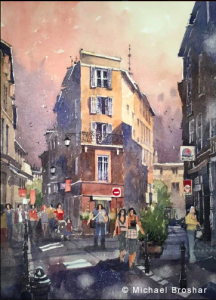Through the medium of watercolor paints and cold pressed paper Michael Broshar shares with his audience an everyday town filled with shoppers. Using an intricate tone, specific layout and dramatic visuals Broshar communicates the ease and fulfillment of growing up in a small community oriented town.
Visuals: Over the entire painting there are no harsh angles or sharp images; every subject is hazy. The painting is full of muted outlines and fuzzy, not formed faces, like a memory from childhood. There are a variety of people – adults, children, a baby in a stroller, all walking close as if everyone is friends or family. From the birds flying around the top of the painting the audience can infer this town is close to the sea, and the light clothing helps detail the time of year as mild in temperature. Broshar is showing his audience the joy of living in a nice climate close to the sea. Nobody in the painting is holding a shopping bag. Due to this detail it appears they are all locals of this town, either taking a walk, or not having started their shopping yet. There are lanterns and street lamps hanging from several of the shops, as well as a single plant in the middle of the sidewalk. No cars can be seen, telling viewers that this is a pedestrian safe place to spend time. Living in a small town similar to this one can allow for activities such as farmers markets or festivals. Broshar presents this quaint village life as a positive, uplifting experience.
Layout: Buildings line the sides of this image, filling the entire frame. Having the buildings drawn up to the top gives the painting a feeling such as being surrounded. The scene depicted seems to be the center of the town, as all the people are concentrated in one area with most every person facing the front. Their body positions also give the appearance of movement in the forward direction. To the artist this is a familiar, positive image. He has seen the town filled to the brim, as well as empty as a ghost town. Living in a place like this allows a person to enjoy their community, as well as experience visitors. As there is nothing that chiefly stands out in this image it is doubtful this is a single memory of a specific day. More likely it is a composite memory, as the artist takes in the scene from all different angles, all different times throughout his childhood to create this particular image.
Tone: Each of the buildings is provided its own muted color, giving them each their own identity. Growing up in a small town allows one to spend time noticing each intricate element. Details of the painting are not sharp, but present out of focus. Additionally, there are not faces on any of the subjects- the artist could not place this memory on a certain day or remember who was around him. Scanning around the image it can be noted there are several ads or signs. Scribbles are present on these details, but not defined. Perhaps this could be a memory before the artist could read, or the ads changed so often one couldn’t keep track.
Pathos: As there are no words in this art, and very little is explained with the title, the audience is left to interpret with their emotions. The soft edges and muted colors provide a feeling of familiarity and security. Small town life is promoted as community oriented and family friendly. Bountiful opportunities to go shopping, enjoy the sea and live in a pleasant climate are afforded when living in a small town. From what the viewer can see of the town it appears safe and inviting. An audience of adults who grew up in a similar environment would find this painting very comforting. However, Broshar is also able to communicate to a group of adults who didn’t grow up with these opportunities. His painting tells of a life not everyone experienced, but one many people dreamed of.
‘Shops’ by Michael Broshar is an example of a piece of art using visuals, layout and tone to convey the artists respect for small town life to his audience. A viewer of this watercolor might use their emotions to interpret a childhood memory of a small seaside town experiencing their nightly shop. Details like birds flying around, and a general softness compel the spectator conjure up a seaside town. The tall buildings and layout of the image invoke feelings of childhood and being dwarfed by surrounding architecture. Audiences are transported to this lovely village through this artistic depiction.

Sources:
Broshar, Michael. Shops. Perry, IA. Michael Broshar Watercolors.
Lunsford, Andrea A., John J. Ruszkiewicz, and Keith Walters. Everything’s an Argument: with readings. 7th ed. Boston: Bedford/St. Martin’s, A Macmillan Education Imprint, 2016. Print
